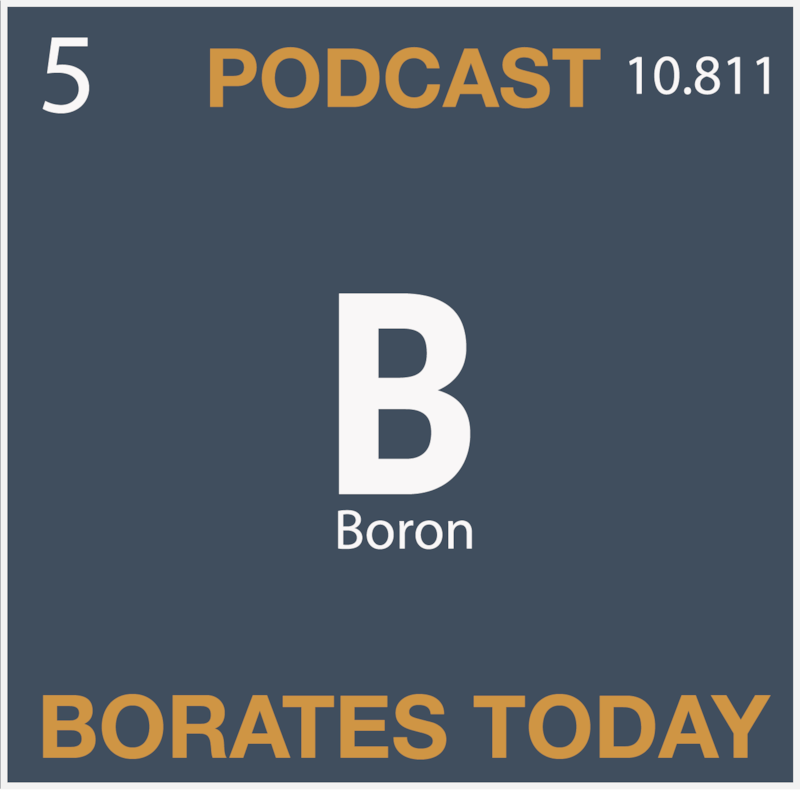
Shownotes
Today, we will look at a sustainable future using materials sciences.
A sustainable future using materials science can be achieved by developing new materials and technologies to help address climate change, dwindling resources, and pollution.
Transcripts
Welcome back to the Borates Today podcast.
Speaker:Each week we cover news on boron and borates that's relevant
Speaker:to the industry and timely.
Speaker:With a range of topics, including the latest industry news we answer questions
Speaker:about the key players in the sector.
Speaker:We also look at the trends, driving demand and supply for boron and we
Speaker:discuss the science behind boron.
Speaker:Who's doing valuable research.
Speaker:How does borne help with decarbonisation with advanced energy?
Speaker:With food security and in providing nutrition.
Speaker:So don't forget to check out born applications and benefits on our website.
Speaker:borates.t oday.
Speaker:Today, we're going to look at a sustainable future
Speaker:using materials sciences.
Speaker:A sustainable future using materials science can be achieved through
Speaker:developing new materials and technologies that can help address climate change,
Speaker:dwindling resources and pollution.
Speaker:From smartphones to high-speed trains, many modern day products depend
Speaker:heavily on dwindling resources.
Speaker:The expectation of which has high environmental and economic expense.
Speaker:According to professor Liu, McDevitt chair of Physics at Georgetown
Speaker:University, we need a bigger toolbox to create greener technology that
Speaker:helps with a sustainable future.
Speaker:He says "it's fascinating as it's a completely new world.
Speaker:Also, we have the power to form up new materials at the atomic level,
Speaker:which possess novel properties besides those developed in their bulk forms.
Speaker:How is boron part of this future?
Speaker:Permanent magnets are used in various applications, including hybrid
Speaker:electric vehicles, magnetically levitated trains, power storage, wind
Speaker:turbines and consumer electronics.
Speaker:However, the rare earth elements they depend on are hard to
Speaker:mine and can be expensive.
Speaker:As a result, there's a critical need to develop replacements that use
Speaker:fewer or even no rare earth elements.
Speaker:Researchers hope that boron-based magnets will lower the carbon
Speaker:footprint in producing permanent magnets with similar properties to
Speaker:those made with rare earth elements.
Speaker:This advancement will make cutting edge technology accessible and an eco-friendly
Speaker:choice for many industrial applications.
Speaker:Neodymium magnets are one of the strongest types of permanent magnets.
Speaker:They're made from the neodymium, iron and boron and they have a very high
Speaker:resistance to heat and corrosion.
Speaker:These magnets are known for their Ferro-magnetic properties, which
Speaker:means they can be magnetized easily and hold onto their magnetism well.
Speaker:They're considered the most powerful magnets due to their smallest
Speaker:size, rare earth magnetic materials with a higher density per volume.
Speaker:Neodymium magnets make advancements in medicine and renewable energy
Speaker:production for a sustainable future.
Speaker:These magnets are super strong magnets that need low heat, high
Speaker:power sources, and are resistant to magnetic demagnetization.
Speaker:Hence they can be made in various shapes and They are versatile materials
Speaker:that can be used for almost anything.
Speaker:Data storage is another area where magnets may be useful.
Speaker:One area where researchers see the potential for significant improvement,
Speaker:is how we store data and computers.
Speaker:The density of magnetic recording media has dramatically increased in recent years
Speaker:thanks to advances in nanoscale magnets.
Speaker:The property that allows digital data to be stored in ever shrinking
Speaker:magnets is the tendency of each bit to sustain its magnetic moment,
Speaker:known as magnetic anisotropy.
Speaker:Present magnetic recording media have precious metals, which are
Speaker:expensive and unsustainable.
Speaker:Back to Professor Liu and Gen Yin who recently received a grant from the
Speaker:National Science Foundation to research magnetic recording media via high entropy
Speaker:routes to create novel magnetic alloys.
Speaker:These alloys include various elements and, surprisingly, they can form stable
Speaker:structures with improved properties.
Speaker:This approach will create novel phases for magnetic recording
Speaker:media applications that can not be obtained through conventional means.
Speaker:Liu is hopeful that his research on magnetic skyrmions, will lead to a new
Speaker:way of storing digital information.
Speaker:Tiny magnetic knots can be formed by incorporating typology into how
Speaker:nanoscale magnets are oriented.
Speaker:These nano magnets are excellent information carriers.
Speaker:Magnetic skyrmions are a type of quasi particle, having a whirling configuration.
Speaker:These nano-sized imbalances are made from a series of knotted inter-locking magnetic
Speaker:moments, invisible to the naked eye.
Speaker:A skyrmion's inter-locking nature provides topological protection and stability.
Speaker:By implementing a single layer of a hydrogen atom in an inert atmosphere
Speaker:onto the surface of a thin magnetic film, researchers introduced a new technique
Speaker:of writing and deleting skyrmions which corresponds to the one and zero states,
Speaker:respectively at room temperature.
Speaker:This is very useful as it's a non-contact way to write and remove information with
Speaker:no need for multiple electric leads.
Speaker:How is this relevant to industry?
Speaker:Mining extraction companies are getting involved in research projects as part
Speaker:of their commitment to understanding and communicating how minerals like
Speaker:boron can be used in new applications, not only for commercial advantage, but
Speaker:for Sustainability and Decarbonization, Advanced Energy, and Food Security.
Speaker:One such company is 5e Advanced Materials, who are building out the only recently
Speaker:permitted boron extraction resource globally, in Southern California.
Speaker:5e Advanced Materials aims to be a vertically integrated leader in the
Speaker:boron Advanced Materials', business.
Speaker:Boron products are in high demand for critical high value applications such as
Speaker:electric transportation, clean energy, food security, and permanent magnets.
Speaker:By sponsoring research into Professor Liu's research group, the company intends
Speaker:to be an active partner in providing strategic minerals for advanced energy.
Speaker:And that's all from Borates Today.
Speaker:For more information on topics related to boron and borates
Speaker:and sustainable materials, don't forget to check out our website.
Speaker:borates.today and our YouTube channel and podcasts .Thanks for listening




